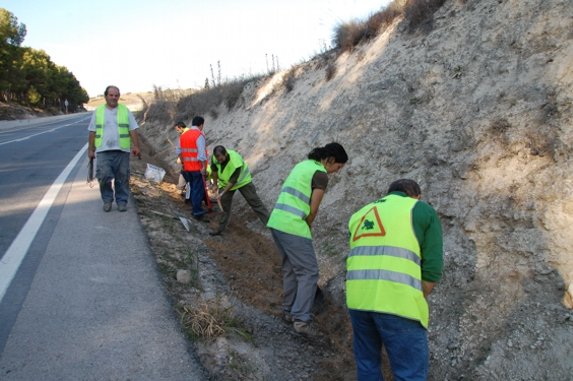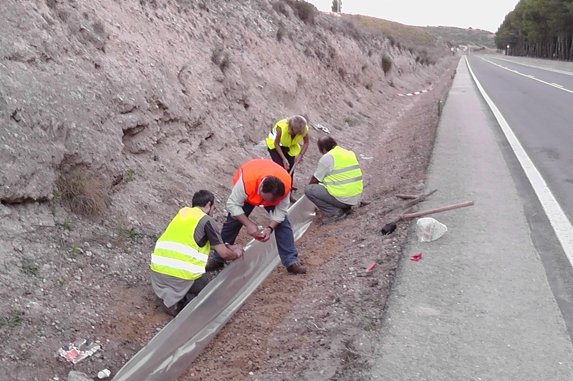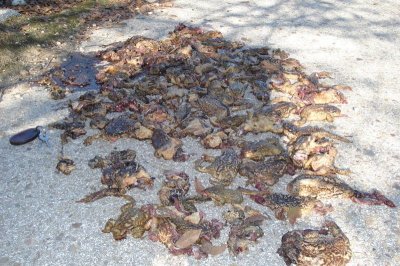Los ejemplares forman parte de la dieta habitual de los habitantes de una aldea junto al río Mekong. Un científico local los descubrió casualmente en la trastienda de un establecimiento de comidas. |





El projecte es porta a terme des de l’any 1992, i està gestionat pel Departament de Medi Ambient de la Generalitat de Catalunya, la Xarxa de Parcs de la Diputació de Barcelona i el CRARC. El projecte compte també amb la participació de totes les instal.lacions col·laboradores del Departament de Medi Ambient en la cria de la tortuga mediterrània. Aquestes intal.lacions privades, proporcionen una part dels exemplars destinats als projectes de conservació. Entre elles trobem el Zoo de Barcelona o entitats pedagògiques com l’Escola Mestral o el IES Ferrer i Guàrdia. Fins un total de 34 persones que a nivell privat han cregut en la conservació de l’espècie. |
|  |
|
Somos un pequeño y variado grupo de voluntarios que intentamos salvar la población de sapo común (Bufo bufo) de los atropellos masivos en la carretera M-301 en San Martín de la Vega. Es la población más importante de sapo común de la comunidad de Madrid. Pretendemos que se pongan barreras para anfibios como en otros lugares ya se ha hecho. El año pasado recogimos unos 1.900 sapos pero no pudimos evitar el atropello de quizás otros tantos. Este año son 1.616 los sapos rescatados en los pocos días de lluvia que ha habido este otoño. Lo hacemos cuando los sapos se activan, es decir, en las noches de lluvia y con temperaturas no muy frías. Muchos de ellos son hembras cargadas de huevos que pretenden llegar al embalse de Gózquez para hacer sus puestas. Los atropellados están siendo otra vez muchísimos, incontables. Los sapos sufren las consecuencias del progreso en cuanto a que han de cruzar un espacio que siempre fue suyo y que ahora es una carretera, un carril bici y un muro de hormigón. El aumento de población de los últimos años en San Martín de la Vega hacen que el tráfico sea más denso y por tanto que los sapos tengan menos oportunidades de salir vivos cuando cruzan la carretera. No podemos prescindir de la carretera, evidentemente, pero conozcamos los problemas que las carreteras sin buenas medidas paliativas provocan. Nuestra naturaleza, que tanta belleza nos ofrece, es descuidada y vulnerada como si fuera un medio para nuestros fines, sin tener en cuenta que la naturaleza es un fin, porque es y porque fue, un principio de vida constante. Si sólo utilizamos la naturaleza como un medio, si no la respetamos como el maravilloso y sorprendente regalo que es, acabaremos con el bienestar del hombre al acabar con ese principio regenerador. El aire que respiramos, el agua que bebemos, la tierra que nos mantiene, es un milagro diario que precisa nuestro agradecimiento, nuestra admiración, nuestra contemplación, nuestro cuidado. Empecemos desde abajo. Os pido vuestra colaboración para salvar sapos comunes. El humilde sapo, con las connotaciones negativas que la palabra sapo conlleva, con las informaciones erróneas que sobre él se ciernen, intenta cruzar una carretera. Conozcámoslo mejor. Ayudémoslo entre todos. Si queréis colaborar, poneos en contacto a través de correo, o por teléfono. Si no podéis, enviádlo y difundidlo por favor, tal vez alguien pueda. Saludos, Elena. valolmo@yahoo.es 650626473. |
T’informem de la pròxima celebració d’una jornada de mig dia sobre conservació de tortugues marines. Más Información.









